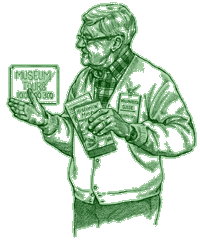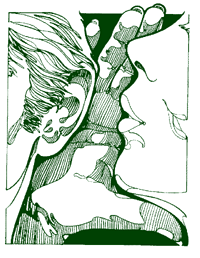 |
|
|||
Objectives Students will be able to:
Materials This assignment could be as simple as recording the information with pad and paper, or could involve using a tape recorder and camcorder. It also could require the use of the computer and the Internet. Copies of a standardized recording form for collecting information (or teacher and student developed one). Example included from Down Jersey Folklife Center. • Access to people involved with local traditions and/or students’ family members. (Could use residents of senior centers or nursing homes as interview subjects.) • There is an abundance of interview subjects that can be found in the Down Jersey region. Perhaps focusing the class on a theme or subject will help narrow the search. For example: Many of the farm markets that are scattered throughout the Down Jersey region are owned and operated by families that may very well represent several generations. Making Connections Saving local history is an enormous compliment to a person because it shows that the person made a difference with his or her life. In relation to the film Down Jersey, recording individuals’ influences, experiences, and traditions is a meaningful way to personalize the significance of the region to the lives of the students and their families. Saving local history could be applied to each family’s learning how to save the memories from their grandparents. It could simply mean writing down and recording where furniture, glassware, or silverware came from. Background The cultural and historical significance of the Delaware Bayshore region of Southern New Jersey has been well documented in both the film Down Jersey and the Blue Book included with this packet. The Table of Contents in the Blue Book is indicative of the diverse and varied influences that have shaped the region and given it its unique character, and would be a good starting point for determining a focus of the students’ investigations. In addition, personal family histories can be developed and would provide meaningful insight into the unique character and diversity of an individual class or group of students. This activity is written in a general way so as to provide the teacher with descriptive methodology in conducting oral histories and is not meant to be specific or inclusive of a particular topic, region, or traditional way of life. • Students’ participation in conducting oral histories provides a valuable lesson in discovering history first-hand, and realizing the importance of everyone’s contributions to the cultural flavor of an area. Of particular significance to recording historical accounts is the necessity for standard information and the accuracy of the interview and recordings made. It is important to relate this to students so that they may be able to discern "truth from fiction." • Tricia Dufford, a Millville artist and art teacher, has worked extensively with students in collecting oral histories and has had them made into booklets. Their first book, about local trapper and poet Tom Brown, was made into a video which can be viewed at the Down Jersey Folklife Center at Wheaton Village in Millville. Their next book was entitled The Grandparent Book and highlighted the students’ grandparents. They are currently (1997-98) writing a booklet about Tony DePalma, Glass Artist, and are thinking about interviewing the Burcham twins about the history of the Burcham farm, and additionally, local artist and painter, Pat Witt, about her life and the history of the Barn Studio of Art. • "Passing it on — Folk Artists and Education in Cumberland County, New Jersey," by Rita Zorn Moonsammy, New Jersey Council on the Arts, Cumberland County Library, National Endowment for the Arts, is also another valuable resource into collecting locally relevant histories from people within the region. It is highly recommended as a resource to obtain insight and information into the historical, cultural, and traditional ways of life so prevalent in the region called "Down Jersey." It is available from The New Jersey State Council on the Arts, CN 306, Trenton, NJ 08625. Procedure Warm Up Students play a game of "Telephone," where a statement is whispered and then passed from student to student. The last student recites aloud what they hear. A comparison is made regarding the actual/initial statement (which is determined by the teacher and can be anything he or she chooses) to the final statement. This provides a powerful example as to the importance of recording accurate information and taking oral histories and putting them into written form. Read an oral passage to the entire class. Students prepare written summaries individually. The entire class compares their statements and interpretations. Utilize a game like charades where students ask questions to learn a set of facts and/or information about the interview subject (the person to be guessed through charades.) This could be easily modeled using a well-known figure in the school/community, where students would have a relatively easy time identifying the “mystery” person. It may be beneficial in providing students with practice by having them write the questions needed to solve the mystery. This could easily serve as the springboard for the development of a survey form/questionnaire that could later be refined and edited for use in conducting their oral histories.
Wrap Up Publish their findings in a booklet to be distributed wherever appropriate. Be sure to include drawings, photographs, etc. Be sure to have the students thank the person(s) interviewed for their willingness to participate and their contributions to local history. Have the students share what they’ve produced with them.
Discuss the value of written journals and diaries and their significance to historical records. Designate a predetermined amount of time within the course of a school day (i.e., five minutes in the beginning/five minutes at the end) to write in a journal. This could be focused on issues that provide a "sense of place" or are open-ended to be determined by the significant events/interactions/issues/ideas for each individual student. Again, the level of direction given toward this assignment/activity is totally up to the individual classroom teacher. • Point out opportunities that exist for students to participate in oral histories through genealogical societies and historical societies. Again, determined by the level of involvement that the teacher wishes to initiate. Assessment As determined by the individual classroom teacher and the extent to which this activity was developed and presented. It is important for students to share what they’ve learned and discuss the information they collected. Extensions The following hints and suggestions are given by Tricia Dufford: Students come up with the questions to ask and practice on each other. The students should break down the life of the person being interviewed into periods such as childhood, young adulthood, and maturity. Have students create a life cycle painting that illustrates the way they view their lives. Students should actually meet the person to be interviewed and tape the responses. This may take several visits. These could take place at the school, but seeing and interviewing a person in his or her natural element and using a tape recorder is preferable for accuracy, comfort level of the person being interviewed and freedom/honesty of answers received. The interview could be made available on the Internet via a school home page. If this is the case, a disc containing the information obtained must be completed. Video can also be utilized via the Internet and computer. This is truly a "talking book" in the most modern sense. Have students research their own families as far back as possible. Particular attention should be paid to the reason(s) their family moved to the area in the first place. A map of New Jersey (United States, and the world) could be utilized for students to track their families’ movements and settlement in the area. Other options: Students could also choose a place to research. An example could be to write the history of a building, or a farm. It could also be to trace the beginnings of the sand industry and see what impact the industry had on local businesses and the economy of the region. Please download the PDF for the complete Lesson Plan.
In addition to your local historical society, Down Jersey Folklife Center at Wheaton Village in Millville. Archives include audiotapes of music and interviews, videotapes, and printed resources. Folklores and Folklife, An Introduction, by Peter Bartis (Library of Congress Pamphlet), available free from the American Folklife Center at the Library of Congress. Passing it On, by Rita Moonsammy (A book with chapters on interviews with Cumberland County Folk Artists which includes lesson plans and activities.) New Jersey Folklore, an anthology by David Cohen Visit the Library of Congress Learning Page at <http://learning.loc.gov/learn/>. Here you will find descriptions of the collections with correlations to school curricula, search guides, sample lesson plans, and student activities. |
|||

 Charting the Course
Charting the Course The Activity
The Activity  Action
Action